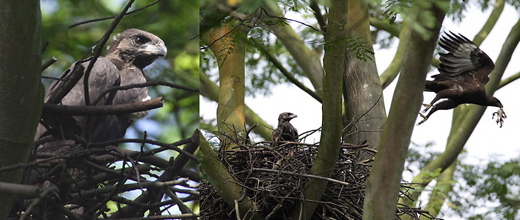In May-July 2006 Mark Chan documented the breeding of a pair of Changeable Hawk Eagle (Spizaetus cirrhatus), both pale morph. The chick that resulted in the union was distinctly a pale morph. The head, neck and underparts were totally white with no markings at all. The local subspecies is limnaeetus.
In June the following year, Johnny Wee and Chan Yoke Meng managed to document the mating of a pale and a dark morph in Singapore (above). Like most other eagles, they build their nest of sticks lodged between the forks of branches in tall trees.
The chick in this case was a dark morph (below left). On 22nd June 2007, the dark morph parent was seen flying past the nest with food in its bill (below right). Was it trying to persuade the chick to fledge by not feeding it in the nest?
Apparently the parent failed as the very next day the chick was seen feeding on a rat in the nest, swallowing it whole (below).
The chick was regularly testing its wings in the nest, as seen on 27th June when the image below (left) was taken. It fledged on or before 6th July as the bird was then seen outside the nest (below right). The dark x pale morph progeny was not all dark, as there were distinct white patches on the breast and flanks (bleow).
The fledged chick returned regularly to the nesting tree for feeding sessions and to roost on the branches.
The Changeable Hawk Eagle exists in two distinct forms or colour morphs. This is a common form of polymorphism (poly = many; morph = form) that occurs in birds, particularly birds of prey.
In this eagle, there is a pale morph and a dark morph. The adult pale morph appears dark brown above and whitish with dark streaks below. Adult dark morph is totally blackish. Each morph may have specific advantages in certain habitats, like certain survival and reproductive advantages. However, what these are, we do not know.
Melinda Chan, Johnny Wee & YC Wee
Singapore
October 2007
Images by Johnny (chick eating rat) and Chan Yoke Meng (the rest)













2 Responses